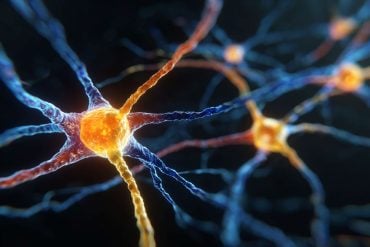Summary: The brain’s structural connectivity alters as a result of long-duration space missions, a new study reports. The most significant changes were identified in white matter tracts, including the sensorimotor tract.
Source: Frontiers
A new study published in Frontiers in Neural Circuits is the first to analyze the structural connectivity changes that happen in the brain after long-duration spaceflight. The results show significant microstructural changes in several white matter tracts such as the sensorimotor tracts. The study can form a basis for future research into the full scope of brain changes during human space exploration.
Our brain can change and adapt in structure and function throughout our lives. As human exploration of space reaches new horizons, understanding the effects of spaceflight on human brains is crucial. Previous research has shown that spaceflight has the potential to alter both the shape and function of an adult brain.
Through a collaborative project between the European Space Agency (ESA) and Roscosmos, a team of international researchers, led by Dr Floris Wuyts of the University of Antwerp, have been studying the brains of humans traveling to space.
Wuyts and his colleagues have, for the first time, investigated structural changes in the brain after spaceflight at the level of deep-brain white matter tracts.
White matter refers to the parts of the brain that are responsible for communication between gray matter and the body and between various gray matter regions. In short, white matter is the channel of communication of the brain and gray matter is where information processing is done.
The learned brain
To study brain structure and function after spaceflight, the researchers used a brain imaging technique called fiber tractography.
“Fiber tractography gives a sort of wiring scheme of the brain. Our study is the first to use this specific method to detect changes in brain structure after spaceflight,” explained Wuyts.
Wuyts and his team acquired diffusion MRI (dMRI) scans of 12 male cosmonauts before and right after their spaceflights. They also collected eight follow-up scans, seven months after spaceflight. The cosmonauts all engaged in long-duration missions of an average length of 172 days.
The researchers found proof of the concept of ‘the learned brain’; in other words, the level of neuroplasticity the brain has to adapt to spaceflight. “We found changes in the neural connections between several motor areas of the brain,” said first author Andrei Doroshin, of Drexel University. “Motor areas are brain centers where commands for movements are initiated. In weightlessness, an astronaut needs to adapt his or her movement strategies drastically, compared to Earth. Our study shows that their brain is rewired, so to speak.”
The follow-up scans revealed that after seven months of returning to Earth, these changes were still visible.
“From previous studies, we know that these motor areas show signs of adaptation after spaceflight. Now, we have a first indication that it is also reflected at the level of connections between those regions,” continued Wuyts.
The authors also find an explanation for anatomical brain shifts observed after spaceflight.
“We initially thought to have detected changes in the corpus callosum, which is the central highway connecting both hemispheres of the brain,” explained Wuyts. The corpus callosum borders the brain ventricles, a communicating network of chambers filled with fluid, which expand because of spaceflight.

“The structural changes we initially found in the corpus callosum are actually caused by the dilation of the ventricles that induce anatomical shifts of the adjacent neural tissue,” said Wuyts. “Where initially it was thought that there are real structural changes in the brain, we only observe shape changes. This puts the findings in a different perspective.”
The future of spaceflight research
The study illustrates a need for understanding how spaceflight affects our body, specifically via long-term research on the effects on the human brain. Current countermeasures exist for muscle and bone loss, such as exercising for a minimum of two hours a day. Future research may provide evidence that countermeasures are necessary for the brain.
“These findings give us additional pieces of the entire puzzle. Since this research is so pioneering, we don’t know how the whole puzzle will look yet. These results contribute to our overall understanding of what’s going on in the brains of space travelers. It is crucial to maintain this line of research, looking for spaceflight induced brain changes from different perspectives and using different techniques,” concluded Wuyts.
About this neuroscience research news
Author: Suzanna Burgelman
Source: Frontiers
Contact: Suzanna Burgelman – Frontiers
Image: The image is in the public domain
Original Research: Open access.
“Brain Connectometry Changes in Space Travelers After Long-Duration Spaceflight” by Floris Wuyts et al. Frontiers in Neural Circuits
Abstract
Brain Connectometry Changes in Space Travelers After Long-Duration Spaceflight
Humans undergo extreme physiological changes when subjected to long periods of weightlessness, and as we continue to become a space-faring species, it is imperative that we fully understand the physiological changes that occur in the human body, including the brain.
In this study, we present findings of brain structural changes associated with long-duration spaceflight based on diffusion magnetic resonance imaging (dMRI) data.
Twelve cosmonauts who spent an average of six months aboard the International Space Station (ISS) were scanned in an MRI scanner pre-flight, ten days after flight, and at a follow-up time point seven months after flight. We performed differential tractography, a technique that confines white matter fiber tracking to voxels showing microstructural changes.
We found significant microstructural changes in several large white matter tracts, such as the corpus callosum, arcuate fasciculus, corticospinal, corticostriatal, and cerebellar tracts.
This is the first paper to use fiber tractography to investigate which specific tracts exhibit structural changes after long-duration spaceflight and may direct future research to investigate brain functional and behavioral changes associated with these white matter pathways.






